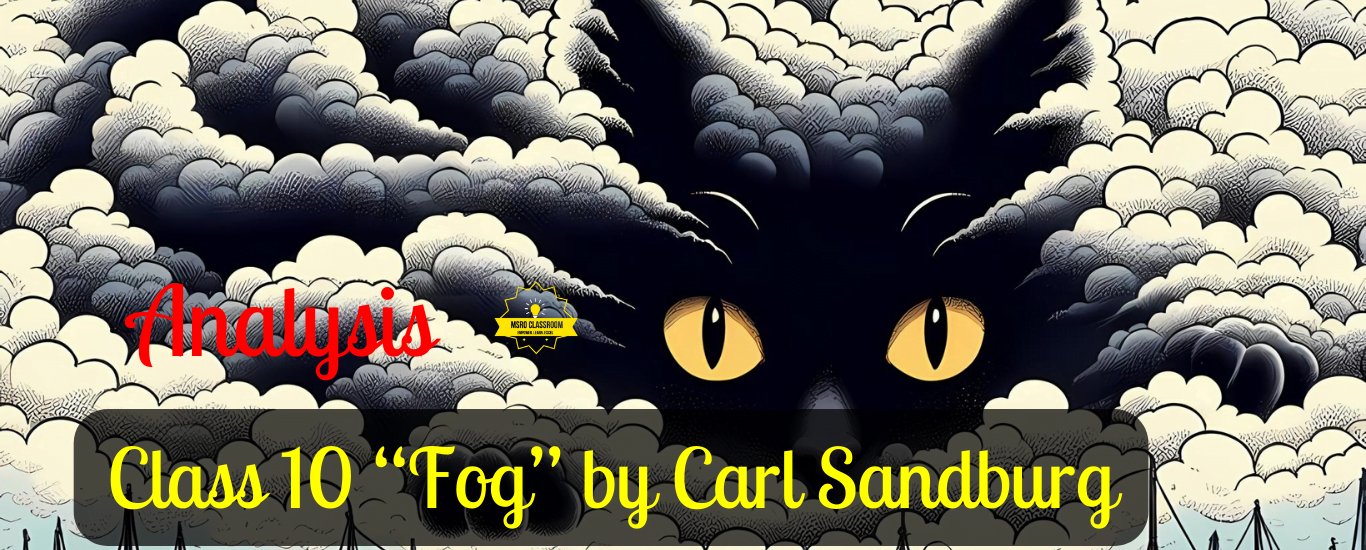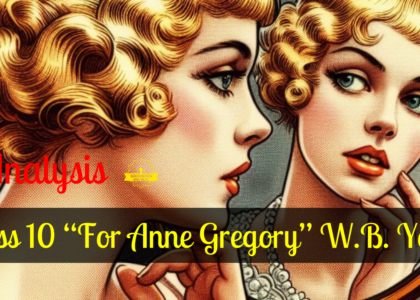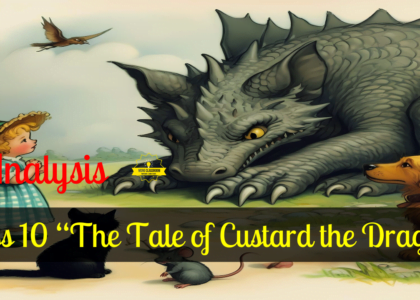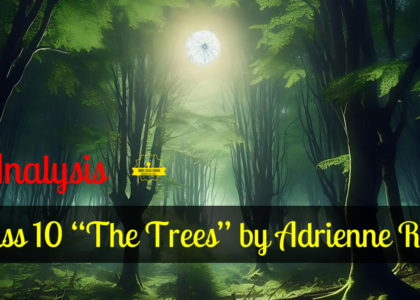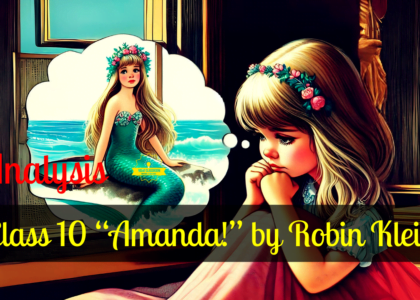Poem 8, Carl Sandburg’s ‘Fog’ Summary, Line-by-Line Explanation, Theme, Literary Devices, Analysis, Extra Questions and Extract-Based Questions.
Poem 8- Fog by Carl Sandburg:
Carl Sandburg
Carl Sandburg (1878-1967) was an American poet, writer, and folk musician renowned for his versatility. His distinct voice, characterised by free verse and a commitment to social justice, solidified his place in American literature.
‘Fog’ is a short poem by Carl Sandburg that was published in 1916 in Sandburg’s first significant poetry collection, Chicago Poems.
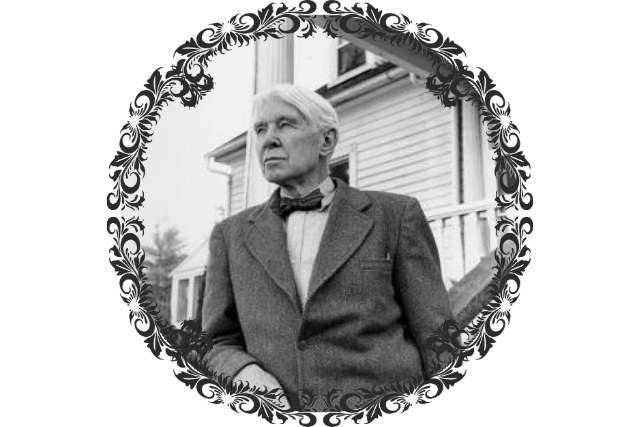
Table of Contents
Next on First Flight: Poem 9- ‘The Tale of Custard the Dragon‘ by Ogden Nash,
Summary “Fog” by Carl Sandburg:
In Carl Sandburg’s poem ‘Fog’, he describes the arrival and departure of fog in a city. The fog is personified as a silent and stealthy cat, coming in quietly and sitting on its haunches as it observes the harbour and city. The fog’s presence is temporary as it eventually moves on, emphasising its transient nature.
Sandburg captures fog’s atmospheric and mysterious qualities, portraying it as a fleeting visitor that briefly envelops the surroundings before continuing its journey. The simplicity of the language adds to the poem’s evocative and contemplative tone.
Central Idea: “Fog” by Carl Sandburg:
“Fog” by Carl Sandburg uses a simple metaphor to describe the fog as a cat. The poem highlights the fog’s quiet and mysterious nature as it moves into a city or harbours silently and subtly. Like a cat, the fog comes without making a noise, sits and observes its surroundings for a while, and then leaves just as quietly.
The central idea is to convey fog’s elusive and gentle movement, emphasising its transient and calm presence. This short, vivid poem helps ESL learners appreciate how descriptive language and metaphors can create strong visual images and convey deeper meanings about natural phenomena.
Justification of the Poem’s Title:
The title “Fog” is simple but significant, directly pointing to the main subject of the poem. It prepares the reader to think about this natural phenomenon. Carl Sandburg chose “Fog” to capture the essence of the poem’s metaphor, where fog is compared to a quiet, graceful cat. The title effectively sets the stage for the imagery and mood of the poem.
The title is easy to understand and remember, helping the readers connect the concept of fog with the poem’s vivid description. It highlights the poem’s focus on fog’s mysterious and transient nature, making the title a fitting and concise introduction to its central idea.
Explanation “Fog” by Carl Sandburg:
- ‘Fog’ by Carl Sandburg is a short and simple poem that uses personification and vivid imagery to depict the nature of fog. Here’s a more detailed explanation:
- The poem opens with the statement, “The fog comes on little cat feet.” Here, the fog is personified as a cat, suggesting its quiet and subtle arrival. The use of “little cat feet” emphasises the gentle and stealthy nature of the fog and conjures an image of softness and delicacy.
- The following lines describe the fog sitting and looking “over harbour and city on silent haunches.” This imagery reinforces the idea of the fog as a silent observer, enveloping the surroundings with a quiet and contemplative presence. The mention of the harbour and city implies that the fog affects both natural and urban environments.
- The poem concludes with the observation that the fog, after sitting for a while, “moves on.” This emphasises the transitory nature of fog. It comes, lingers for a time, and then departs, much like a cat that might come and sit somewhere briefly before wandering away.
- To conclude, Sandburg’s ‘Fog’ captures the essence of fog as a mysterious and transient phenomenon that can momentarily alter the atmosphere and create a sense of quiet beauty. Using personification and simple yet evocative language contributes to the poem’s charm and impact.
Analysis “Fog” by Carl Sandburg:
Carl Sandburg’s ‘Fog’ artfully captures the essence of fog through personification and metaphor, vivid imagery, and a reflection on the transient nature of this atmospheric phenomenon. Sandburg’s skilful use of language invites readers to contemplate the beauty of the natural world and the deeper meanings that can be extracted from seemingly simple observations.
Tone:
Carl Sandburg’s poem ‘Fog’s tone can be described as calm , contemplative, and observant. The language throughout the poem is simple, contributing to a calm and reflective atmosphere. The personification of fog as a cat, with “little cat feet,” creates a gentle, almost whimsical tone.
The fog is presented as a silent, unobtrusive presence, and this choice of tone allows readers to contemplate its nature and its transient qualities without the distraction of intense emotions.
To summarise, the tone of ‘Fog’ is subdued and meditative, inviting readers to engage thoughtfully with the imagery and themes presented in the poem.
Type:
‘Fog’ by Carl Sandburg is a free verse poem. It lacks a regular rhyme scheme, meter, or formal structure and relies on the natural cadence of everyday speech. The absence of a rigid structure gives the poem a sense of informality and allows the poet to focus on conveying the essence of the fog more flexibly and expressively. The use of free verse is a characteristic feature of Sandburg’s style, and it adds to the simplicity and accessibility of the poem.
Theme “Fog” by Carl Sandburg:
- Transience and Impermanence: The poem emphasises the temporary nature of fog, portraying it as a fleeting presence that comes and goes. The word “moves on” in the final line underlines the idea of impermanence. This theme extends beyond the fog, metaphor the transient nature of life and experiences.
- Observation and Contemplation: The poem presents the fog as an observer, sitting and looking “over harbor and city on silent haunches.” This theme suggests the importance of taking the time to observe and contemplate the world around us. It highlights the value of stillness and reflection in appreciating the beauty and significance of ordinary moments in life.
- Mystery: The comparison of fog to a cat and its silent movements introduces an element of mystery. The poem invites readers to reflect on the symbolic significance of these natural occurrences and find meaning in the ambiguity.
Simplicity and Depth:
The poem carries a deep meaning despite its brevity. The simplicity of language and structure enhances its accessibility, but within this simplicity lies a contemplative reflection on the fleeting nature of life and the beauty found in transient moments.
Extended Metaphor in “Fog” by Carl Sandburg:
Carl Sandburg’s poem ‘Fog’ can be interpreted as an extended metaphor. In this case, the fog is not merely described or compared to a cat in a single instance; the entire poem consistently extends this comparison, using it as a metaphor to convey broader ideas. Let’s examine how:
- The personification of Fog as a Cat: The opening line establishes the metaphor by personifying the fog as having “little cat feet.” This initial comparison sets the tone for the poem, suggesting that the fog shares qualities with a cat.
- Cat-Like Behavior of the Fog: The metaphor is extended as the poem progresses. The fog is not just compared to a cat in one aspect; it is described as a living entity with intentional actions. The fog “comes on little cat feet,” “sits looking,” and “moves on,” attributing cat-like behaviours to the fog.
- Quiet and Stealthy Presence: The metaphorical comparison enhances the understanding of the fog’s characteristics. Cats are known for their quiet and stealthy movements, and by extending this metaphor, the poem conveys that the fog shares these qualities, arriving silently and unobtrusively.
- Observational Quality: The poem further extends the metaphor by portraying the fog as an observer, sitting and looking “over harbor and city on silent haunches.” This aligns with the image of a cat observing its surroundings.
- Transience and Departure: The metaphor reaches its culmination as the fog, like a cat that may lose interest and move on, eventually “moves on.” This departure reinforces the idea of the fog’s transient and fleeting nature, echoing the ephemeral quality often associated with cats.
Hence, the entire poem is an extended metaphor by consistently likening the fog to a cat throughout its progression. This metaphor enhances the poem’s imagery, creating a vivid and cohesive portrayal of the fog’s characteristics, behaviours, and transient nature through the lens of the cat metaphor.
Personification:
The central element of the poem is the personification of fog as a cat. Describing the fog as having “little cat feet” gives it a sense of stealth and quiet movement. This choice of imagery also introduces a tactile and sensory dimension to the fog, suggesting a soft and almost intimate quality.
Imagery:
The poem paints a clear picture through its imagery. The fog is a meteorological phenomenon and a living entity with actions. It “comes on little cat feet,” “sits looking over harbour and city on silent haunches,” and “moves on.” These images create a vivid and memorable portrayal of the fog’s behaviour, enhancing the reader’s connection to the natural element.
Line-by-Line Explanation “Fog” by Carl Sandburg:
- “The fog comes”
The opening line sets the stage for the poem, announcing the arrival of fog.
- “on little cat feet.”
The second line uses personification, likening the movement of the fog to the quiet and stealthy steps of a cat. It introduces a gentle and almost whimsical image.
- “It sits looking”
The fog is described as a living entity (cat) capable of sitting and observing its surroundings.
- “over harbor and city”
The fog’s gaze extends over natural (harbour) and urban (city) environments, emphasising its pervasive nature.
- “on silent haunches”
The fifth line continues the personification, describing the fog as if it were a cat sitting quietly and attentively, emphasising its silent and unobtrusive presence.
- “and then moves on.”
The poem concludes by highlighting the transient nature of the fog. After quiet observation, it departs, reinforcing the idea of impermanence and change.
Literary Devices “Fog” by Carl Sandburg:
Questions Answers “Fog” by Carl Sandburg:
Textbook Questions Answers:
Q1: What does Sandburg think the fog is like?
A1: Sandburg thinks the fog is like a cat. He uses the metaphor of a cat to describe the qualities and movements of the fog. The fog is portrayed as having “little cat feet,” suggesting a quiet, subtle, and almost stealthy arrival.
Q2: How does the fog come?
A2: The fog comes quietly and unobtrusively, described as arriving “on little cat feet.” This imagery emphasises the gentle and soft nature of the fog’s approach.
Q3: What does ‘it’ refer to in the third line?
A3: The “it” in the third line refers to the fog. The line reads, “It sits looking,” personifying the fog as if it were a living entity capable of sitting and observing.
Q4: Does the poet say that the fog is like a cat? Find three things that tell us that the fog is like a cat.
A4: Yes, the poet uses the metaphor of the fog being like a cat throughout the poem. Here are three things that suggest the fog is like a cat:
- “on little cat feet“: The second line directly compares the fog to a cat, describing its movement in terms of the quiet steps of a feline.
- “It sits looking / over harbor and city / on silent haunches“: These lines attribute cat-like behaviour to the fog, as it is described as sitting and looking over the landscape with silent haunches, further reinforcing the metaphor.
- The fog’s quiet, subtle, and observational nature throughout the poem mirrors the characteristics commonly associated with cats, contributing to the extended metaphor.
Extra Questions “Fog” by Carl Sandburg:
Short Answer Type Questions:
Q1: What is the central theme of Carl Sandburg’s poem ‘Fog,’ and how does the poet use language and imagery to convey this theme?
A1: In ‘Fog,’ the central theme revolves around the transient nature of life and the beauty found in fleeting moments. Carl Sandburg employs vivid imagery and personification, mainly through the metaphor of fog as a cat, to convey nature’s impermanence and quiet elegance. The poet uses simple and evocative language, creating a contemplative atmosphere that encourages readers to reflect on existence’s temporary yet enchanting aspects.
Q2: Describe the metaphorical significance of the fog being compared to a cat in Carl Sandburg’s poem. How does this metaphor contribute to the understanding of the poem?
A2: The poem’s central and extended metaphor is the fog compared to a cat. Sandburg creates a vivid and cohesive portrayal by describing the fog as having “little cat feet” and attributing cat-like behaviours such as sitting and looking at the fog.
This metaphor enhances the reader’s understanding by conveying the fog’s quiet, subtle movements and observational, transient nature. It adds depth to the poem, inviting readers to contemplate the metaphorical layers that enhance the portrayal of the fog’s characteristics and the broader themes of impermanence.
Q3: How does the poet use personification in the poem ‘Fog, and what effect does it have on the overall tone and atmosphere of the poem?
A3: Personification is evident in ‘Fog’ as the poet attributes human-like qualities to the fog, particularly by describing it as having “little cat feet” and sitting “on silent haunches.” This personification contributes to a contemplative and almost whimsical tone. By imbuing/instilling the fog with the characteristics of a cat, the poem creates a unique and imaginative portrayal, enhancing the reader’s connection to the natural element. The overall atmosphere is one of quiet observation and transience, evoking a sense of mystery and beauty in the simplicity of nature’s movements.
Q4: How does the poet convey the idea of transience in ‘Fog,’ and what symbols or images contribute to this theme?
A4: The idea of transience is prominently conveyed in ‘Fog’ through the metaphor of the fog’s fleeting presence. The poem emphasises the impermanence of the fog as it “comes on little cat feet” and eventually “moves on.” The choice of a cat as a metaphor, the quiet movements of the fog, and its observational nature all contribute to the theme of transience. The fog’s departure, akin to a cat losing interest and moving on, reinforces the notion that everything in life, even something as seemingly stationary as fog, is temporary.
Q5: How does the poet describe the movement of the fog in the poem?
A5: The poet describes the fog’s movement as quiet and stealthy, likening it to a cat. It arrives “on little cat feet,” sits silently over the harbour and city, and then moves on without a sound. This metaphor emphasises the fog’s gentle, elusive, and transient nature.
Q6: What animal is the fog compared to in the poem?
A6: In the poem, the fog is compared to a cat. The poet describes it arriving “on little cat feet,” highlighting its silent, graceful, and unobtrusive presence. This metaphor captures the fog’s quiet and mysterious nature as it moves into and out of the city and harbour.
Q7: What does the fog do after it comes on “little cat feet”?
A7: After the fog comes on “little cat feet,” it sits silently, looking over the harbor and city. It remains still and observant, like a cat sitting quietly on its haunches, before it eventually moves on. This imagery conveys the fog’s transient and calm presence.
Q8: How does the poem create a sense of quietness and mystery?
A8: The poem creates a sense of quietness and mystery by comparing the fog to a cat, using phrases like “little cat feet” and “silent haunches.” The fog’s stealthy arrival, silent observation, and gentle departure evoke a calm, elusive atmosphere, enhancing the mysterious quality of its presence.
Q9: Why is the fog described as sitting “on silent haunches”?
A9: The fog is described as sitting “on silent haunches” to emphasise its quiet and still nature. Like a cat resting calmly and observing its surroundings, the fog sits silently over the city and harbour. This imagery highlights the fog’s gentle, unobtrusive presence and mysterious, transient quality.
Long Answer Type Questions:
Q1: How does Carl Sandburg use animal imagery to describe the fog in the poem “Fog”? Discuss the effectiveness of this imagery in conveying the characteristics of fog.
A1: In “Fog,” Carl Sandburg uses animal imagery by likening the fog to a cat, describing it as coming “on little cat feet.” This metaphor effectively conveys fog’s quiet, stealthy, and graceful nature. Like a cat, the fog arrives silently, sits with a watchful stillness, and then moves on without a sound.
This imagery captures fog’s ephemeral and elusive qualities, emphasising its transient and mysterious presence. The comparison to a cat also evokes a sense of gentle, almost playful movement, contrasting with more ominous or heavy portrayals of fog. Sandburg’s simple yet vivid metaphor makes the fog’s behaviour relatable and easily visualised, enhancing the poem’s impact.
Q2: What mood or atmosphere is created by the description of the fog in “Fog”? How does Sandburg’s choice of words contribute to this mood?
A2: Carl Sandburg’s “Fog” mood is tranquil and contemplative. The description of the fog coming “on little cat feet” evokes a sense of quietness and subtlety, suggesting a gentle, almost serene presence. Words like “silent haunches” enhance this calm atmosphere, emphasising the fog’s noiseless and discreet nature.
The imagery of the fog sitting and watching “over harbour and city” adds a contemplative, watchful quality, as if the fog is a quiet observer of the world. Sandburg’s concise and precise word choice creates an atmosphere of peacefulness and fleeting beauty, allowing the reader to feel the quiet, transient nature of the fog as it comes and goes without disruption.
Q3: In what ways does the poem “Fog” reflect the nature of fog through its structure and language? Provide specific examples from the text to support your analysis.
A3: The poem “Fog” reflects the nature of fog through its concise structure and simple language. The brevity of the poem, consisting of only six lines, mirrors the transient and elusive nature of fog, which appears and disappears quickly. The line breaks to create a slow, deliberate pace, mimicking the fog’s gradual movement.
Phrases like “on little cat feet” and “silent haunches” use minimal but vivid imagery to convey the fog’s quiet and stealthy presence. The poem’s sparse, unembellished language reflects the fog’s simplicity and subtlety, avoiding complex descriptions to capture the essence of fog with directness and clarity. This minimalist approach effectively encapsulates the fog’s fleeting, gentle presence over the harbour and city.
Q4: How does the personification of the fog in “Fog” influence the reader’s perception of the natural phenomenon? Why do you think Sandburg chose to depict the fog in this manner?
A4: The personification of the fog in “Fog” as a cat significantly influences the reader’s perception by giving the natural phenomenon a gentle, almost mystical character. Describing the fog as coming “on little cat feet” and sitting “on silent haunches” evokes an image of a quiet, graceful, and observant creature.
This personification makes the fog feel more alive and relatable, transforming it from a mere weather condition into a presence with intentions and behaviour. Sandburg likely chose this depiction to highlight the fog’s delicate and ephemeral nature, contrasting with more ominous or oppressive portrayals. By personifying the fog, Sandburg invites readers to view it as a transient, almost sentient visitor, enriching their emotional and sensory experience of the poem.
Q5: What is the significance of the fog “sitting” and “moving on” in the poem “Fog”? How does this movement contribute to the theme or message of the poem?
A5: In “Fog,” the imagery of the fog “sitting” and then “moving on” signifies its transient and contemplative nature. The fog’s sitting suggests a moment of stillness and observation, imparting a sense of calm and quiet reflection over the harbour and city.
The pause in the fog’s movement symbolises a temporary presence, emphasising the idea of impermanence. The eventual movement of the fog, as it “moves on,” reinforces the theme of transience, highlighting the fleeting nature of fog and life’s moments.
This gentle, unhurried departure underlines the poem’s message about the beauty in transience and the serene, almost meditative quality of natural phenomena as they come and go, leaving subtle impressions behind.
Q6: How does the brevity/shortness of the poem “Fog” by Carl Sandburg affect its impact on the reader? Discuss how the concise form enhances the poem’s meaning.
A6: The brevity of Carl Sandburg’s “Fog” intensifies its impact by mirroring the fleeting nature of fog itself. The poem’s concise form forces each word to carry significant weight, creating a vivid, memorable image with minimal language. This succinctness captures the fog’s brief presence, enhancing the theme of transience.
The short lines and simple structure reflect the fog’s quiet, discreet arrival and departure, making the poem feel like a quick, passing moment. The brevity leaves a lingering impression, like a fog that momentarily shrouds a landscape before disappearing.
By distilling the essence of the fog into just a few lines, Sandburg amplifies its mysterious, gentle beauty, allowing readers to experience the fog’s delicate, transient nature more acutely.
Q7: How does Sandburg’s depiction of the fog in “Fog” compare to other common representations of fog in literature or art? What unique perspective does he bring through this poem?
A7: Sandburg’s depiction of the fog in “Fog” contrasts with common representations of fog in literature and art, often portraying it as ominous, heavy, or obscuring.
Instead, Sandburg presents the fog as gentle and graceful, likening it to a cat that creeps and sits observantly. This unique perspective emphasises the fog’s transient beauty and serene presence rather than its potential to create confusion or gloom.
Sandburg transforms the fog from a mere weather condition into a peaceful, contemplative force by personifying it with delicate, almost playful imagery. His portrayal highlights the fog’s ephemeral and hidden nature, offering a refreshing, calming view that invites readers to appreciate life’s quiet, subtle moments.
Q8: What feelings or thoughts does the poem “Fog” evoke in you as a reader? Explain how the imagery and structure of the poem contribute to these reactions.
A8: As a reader, “Fog” evokes a sense of tranquillity and introspection. The imagery of the fog coming “on little cat feet” conjures a peaceful, almost magical atmosphere, inviting contemplation of the natural world. The short, concise lines and simple structure mirror the quiet, gradual movement of the fog, fostering a feeling of serenity and stillness.
The personification of the mist/fog as a gentle observer adds to the sense of calm, as if nature is quietly watching over the scene. The poem’s imagery and structure work harmoniously to create a meditative space, encouraging reflection on the beauty and transience of life’s fleeting moments.

